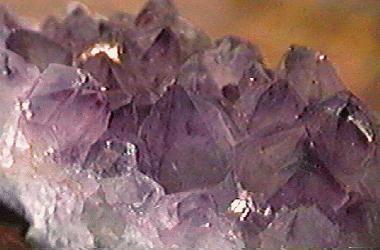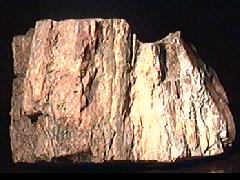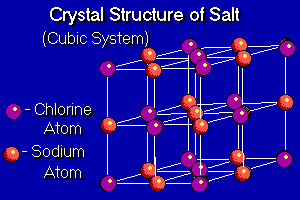pop up description layer
HOME
Cryptozoology UFO Mysteries Aviation Space & Time Dinosaurs Geology Archaeology Exploration 7 Wonders Surprising Science Troubled History Library Laboratory Attic Theater Store Index/Site Map Cyclorama
Search the Site: |
|
x
Crystals: Flowers of the Mineral KingdomThey can be as common as table salt, as numerous as grains on a beach, or as rare as diamonds. They are crystals. The smallest particle of any substance is called a molecule. Each molecule, in turn, is composed of one or more atoms. Atoms are the smallest particle of an element. An element is one of a hundred or so materials that can be combined with other elements to make all the substances in the universe. For example, a sodium atom (one element) bound to a chlorine atom (another element) makes a molecule of sodium chloride, a substance commonly known as table salt. The molecules in a gas or liquid bounce or flow around each other freely. When the material changes into a solid state, the molecules lock together. As they do, they link to one another in a uniform pattern that is repeated over and over. The result is known as a crystal. Crystals often appear as strange and beautiful geometric shapes. Quartz, perhaps the most common of the mineral crystals, always grows as six-sided columns. The shape is a direct result of how the quartz molecules prefer to link up. Each quartz molecule is composed of four atoms of oxygen and one of silicon. As long as the crystal is undisturbed by another crystal as it grows, additional molecules join it following a pattern that preserves its six-sided structure.
Each system has different characteristics that define it. For example, in the cubic system all crystals have 90 degree angles and the axes are of equal length. In the triclinic system all the axes are of different lengths and no angle is 90 degrees.
When crystals are cut, as when they are when being prepared to be used in jewelry, they must be sheered along particular axes, or cleavage planes of the crystal. Trying to cut across them may cause the crystal to shatter: an expensive mistake if the mineral being cut was a valuable gemstone. A single material can crystallize into different molecular patterns under different conditions. For example, when carbon crystals form under great temperature and pressure, they can become the hardest of all known materials: the diamond. A diamond, if pure, is clear. If the crystals form under other conditions, the carbon can take the form of graphite, commonly referred to as "pencil lead," which is very soft, opaque and black. Crystals do not just come from minerals. Most substances will form a crystal if allowed to solidify under the right conditions. Usually the slower the process happens, the more likely it will be that the molecules will find their proper place in the growing crystal's structure. Water will form crystals under several conditions. Snowflakes are examples of water crystals which have formed from water vapor in the air and then assembled themselves into a flat, lacy mass. Although snowflakes are the most spectacular form of water crystals, the crystals form whenever ice occurs. Sugar is an example of common organic crystal. While to the naked eye it may look identical to table salt, examination with a microscope, or even a good magnifying glass, will reveal that the two crystals are of different shapes because they belong to two different crystal systems.
The word crystal comes from the Greek krystallos, which means ice. The Greeks found beautiful quartz crystals in the Alps mountains and believed that they were a form of water frozen so hard that they would never thaw. Ancient peoples often valued quartz crystal (which they referred to as rock crystal) for its beauty and even believed that it had supernatural powers. Rock crystals were sometimes sculptured into shapes. An examples of this are the famous crystal skulls. Also, crystal balls, sometimes claimed to be used to foretell the future, are pure quartz crystals polished into spheres.
Crystals can also form within dead, organic material if the material has been buried and minerals have seeped into it. Rather than taking the natural crystal shape, the crystal will form along the lines of the original living material. This result is called a fossil.Examples of this are dinosaurs bones and petrified wood. Crystals have other value beyond just being pretty. Many crystals have, but especially quartz, a property called piezoeletricity. If the crystal is cut in the proper way, when it is squeezed it will create a tiny electrical charge along it's edges. One practical use of this is in microphones where quartz crystals are mounted to detect the pressure waves from sound and turn them into electrical signals. The electrical signals can then be sent, recorded, or amplified and turned back into sound by a speaker. The piezoelectrical effect can be reversed so that when an electrical charge is applied to the crystal it will warp as if it were under pressure. By cutting the crystal precisely and applying the right charge, it can be made to vibrate at a constant speed. This causes the electricity to also pulse at the same frequency. The resulting device is called an oscillator and is used in a wide variety of applications including TV and radio transmitters and receivers. Quartz crystals can also provide oscillations that can be used to drive clocks. The first quartz crystal clock was built in 1928, and many of today's cheap digital watches use quartz crystal oscillators. A quartz crystal clock will not vary more than a thousandth of a second per day. The study of crystals is crystallography and the scientist who makes the study is a crystallographer. One material that is commonly mistaken for crystal is glass. While glass is very similar in composition to quartz, it has no fixed geometrical arrangement of its atoms and molecules. Strangely enough, glass, though it is rigid, is not technically a solid, but is actually considered a supercooled liquid. Copyright Lee Krystek 1998. All Rights Reserved. |
|
Related Links |
|
|




 Depending
on the molecules involved in making the crystals, different
shapes may result. There are believed to be seven shapes, or
"systems" into which crystals can form. They include cubic,
hexagonal, tetragonal, orthorhombic, monoclinic, and triclinic.
Diamonds, the hard and beautiful stones often used in jewelry
are an example of the cubic system. The ruby, a red
gemstone, is a member of the hexagonal system. Topaz is in the
orthorhombic system.
Depending
on the molecules involved in making the crystals, different
shapes may result. There are believed to be seven shapes, or
"systems" into which crystals can form. They include cubic,
hexagonal, tetragonal, orthorhombic, monoclinic, and triclinic.
Diamonds, the hard and beautiful stones often used in jewelry
are an example of the cubic system. The ruby, a red
gemstone, is a member of the hexagonal system. Topaz is in the
orthorhombic system.


 Quartz
is one of the most abundant mineral crystals and can take many
forms. Pure quartz is clear, but when the crystal is formed
in the presence of minerals like iron, aluminum, manganese or
titanium, atoms from these can substitute for the silicon atoms
in the crystal, giving it a tint or color. Amethyst (top
of page) is violet quartz crystal.
Quartz
is one of the most abundant mineral crystals and can take many
forms. Pure quartz is clear, but when the crystal is formed
in the presence of minerals like iron, aluminum, manganese or
titanium, atoms from these can substitute for the silicon atoms
in the crystal, giving it a tint or color. Amethyst (top
of page) is violet quartz crystal.
